
Please send information to: Department of Physics &
Astronomy,
Alumni Records
800 Yale Blvd NE, Albuquerque, NM 87131,
or send e-mail to Mary DeWitt, or
fill out the online
form.
Click on the names for more information.
1930s [ back to top
]
David A. Lawson, Jr. -
12/16/1913-4/30/1990
Fairfax, VA
1940s [ back to top
]
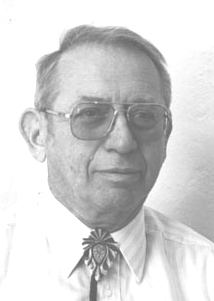 Marx
Brook - 7/12/20-9/3/02
Marx
Brook - 7/12/20-9/3/02
Marx Brook, longtime Professor of Physics and Professor
Emeritus (retired in 1986) and Director of Langmuir
Laboratory for Atmospheric Research at New Mexico Tech,
passed away on Tuesday, September 3, 2002,
while in the hospital following emergency abdominal
surgery.
Paul Krehbiel, one of his former students,
wrote Marx's
obituary.
Raymond Grenchik - 4/28/2000
Raymond Grenchick died September 28, 2000, in Baton
Rouge,
LA. After earning the M.S.-Physics here at UNM
in 1949 (thesis: "A New Method of Measuring the
Intensity
of the Zodiacal Light," under Victor Regener), he
went to Indiana University for the PhD (1956). While
at Indiana he studied under the late Marshall Wrubel, and
his dissertation was one of the earliest attempts to
model the atmosphere of a white dwarf star. Most of his
career was spent in the Dept of Physics & Astronomy
at Lousiana State University...1957 until his retirement in
1988.
Herschel R. Snodgrass -
5/31/1913-6/12/1990
King, Washington
1950s [ back to top
]
Allan F. Beck - 7/3/17-11/7/02
Lt. Col. (Ret.) Allan F. Beck died at St. Thomas
Hospital,
Nashville, Tennessee of complications from kidney
failure. Lt. Col. Beck was born July 3, 1917 in
Escanaba,
Michigan. He went to school in Escanaba and graduated
as valedictorian of his high school class in 1935.
After
entering the Army Air Corps, he was stationed at
Randolph Field and Kelly Field in San Antonio, Texas.
Upon leaving active duty he served in the USAF Reserve,
retiring as a Lt. Col. He earned a master's degree in
physics at UNM in 1951, and worked at Sandia National Laboratories
as a nuclear physicist; he retired after 31 years of
service. He married Louise Duggin (d. April 19, 2003) and their 59 year
marriage brought them three children who survive, Ellen
(John) Anderson, David (Cindy) Beck and Elizabeth Estrada;
five grandchildren; brothers, Arol (Dudley, deceased),
and Jack (Bette) Beck, of Escanaba, Michigan.
Robert Jackson Lanter (Capt, USN,
1942-46)-
11/09/1914-10/30/1986
David Pomeroy - 1897-1974
He wrote the first UNM Dept of Physics & Astronomy
doctoral
dissertation (1950). Dr. Pomeroy subsequently taught
at the University of Florida, Gainesville, and conducted research at the
Army Medical Research Lab, Fort Knox.
William A. Rogers - 9/6/96
William Rogers retired from Brookhaven on February 15,
1984, after 34 years of Lab service; he was 76 years old. He had
joined BNLs Purchasing Group on August 1, 1949, and at
the time of his retirement he was a senior contracts specialist
in the Division of Contracts & Procurement.
James F. Tribby - 1914-1997
His death was recorded with Rockefeller Memorial
Chapel,
University of Chicago.
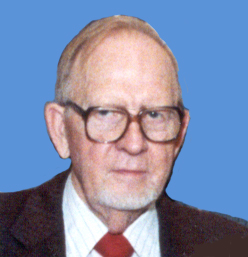 Gus
T. Zorn - 6/18/1924-1/30/2002
Gus
T. Zorn - 6/18/1924-1/30/2002
Professor Emeritus and Senior Research Scientist, Gus
Zorn passed away on
January 30, 2002, after a long struggle with
Alzheimer’s
and Parkinson’s diseases.
He received his Ph.D. at the University of Padua,
Italy
in 1954. He spent one year
as a visiting scientist at the Max Plank Institute of
Physics (1958) while serving as
an associate physicist at the Brookhaven National
Laboratory
(1956-1962). He
was a recipient of the General Research Board Award for
the year 1987-1988,
an APS Fellow and a member of the New York Academy of
Sciences. Gus
was a participant in the OPAL
and JADE experiment as
well as a number of other important high energy
physics experiments at the
University of Maryland.
In honor of his wife (Bice
Sechi-Zorn, also a physicist) who died in 1984, Gus
established a Francis Scott
Key Scholarship Fund at the
University of Maryland in
her honor. This fund benefits outstanding science
students
with an interest in physics.
His last wish was to establish the Gus T. Zorn and
Bice
Sechi-Zorn
Professorship in
Experimental Physics.
1960s [ back to top
]
James R. Barcus - 9/30/1930-1/3/1988
The Barcus Glacier, in the Hutton Mountains, was named
by
US-ACAN for James R. Barcus, who was an
ionospheric
physics researcher at Byrd
Station in the summers 1966-67
and 1967-68.
Daniel P. Christman (Col., U.S. Army)
- 2/11/1930-1/17/1975
El Paso, TX
R.R. Harrington - 1932-1991
Russell G. Herron - d. 1989
He taught at UCLA and at St. John's Seminary College
in Camarillo, CA, from 1965-1989;
this is his grandaughter's tribute (located
online at Your
True Hero).
A
TRIBUTE TO MY GRAMPA
By Winona Nash
My
grandfather, Russell G. Herron,
Jr., is both a challenge and a breeze to write about.
I have been told
many times from most all of my extended family about his heroic
attributes.
However, I have not been able to physically be with him
since 1989, when he died. He died
of diabetes quietly in the night, and
many people would agree that he had chosen that time
as the right time
to move on from this life to another place. Nonetheless, my memories of
him and the things I have been told make me admire my grampa greatly.
My
grampa grew up in Chicago, and
decided to join the Navy. Some say he joined to pay
for college
education, while it is possible he joined to move up and away from his
troubled
family. I think it is a combination of both. In the Navy,
Grampa became a Commander and
served his country with patriotism. I
have read several essays that he wrote, allowing me to
see what an
unwavering American he truly was. He served in the Korean War, never
talking
much to us about his experiences. I think that too is
admirable, as he truly was respectful
and committed to his duties, not
taking any opportunities to boast regarding the gravity of war.
One of
the few memories I have of
my Grampa is his funeral, with a twenty-one-gun salute
from the Navy
and the dramatic folding of his esteemed flag. Truly my grampa was and
is a
model of patriotism, pride, and duty.
Grampa
Herron was also a very
smart man. He earned a PhD in Physics and an EdD in Education.
Using
these tools, he became a professor at UCLA and composed his own theory
involving the
electro-magnetism of matter. This theory, composed in the
1950s, was considered “ fifty years
ahead of its time;” accordingly, it
is now starting to get some recognition. My grampa has
inspired me to
look into Physics as a natural career choice.
Additionally,
my grampa was
outstanding in his pursuit for improving the lives of the mentally
retarded. You see, my Uncle Jim was born mentally retarded, possibly
because of radiation
my grampa was exposed to while studying physics at
University of California in Berkeley.
Grampa Herron became a national
figure in the cause for mental retardation and handicapped
children,
organizing a foundation in Ventura County that is still a leading group
for the
developmentally disabled.
Besides
all these accomplishments,
my grandfather was active in politics. He was dutifully
honest, which
possibly became his greatest weakness in the political arena. While it
is nice
to daydream about him serving in the Oval Office, it is more
rewarding to know that my
grampa was an upstanding citizen, and honest,
too.
It is
obvious to see how important
my grampa was upon looking around my gramma’s house.
The study’s walls
are covered with plaques from the California government honoring him in
life
and death. There was a star named after him. He is the only Grampa
that I have ever known,
and as I get older, I can only wish that I had
the opportunity to get to know this amazing man.
I consider him a hero,
a man whose greatness has passed into familial legend. To me, he
shines
as a beacon of patriotism, genius, charity, and civic generosity.
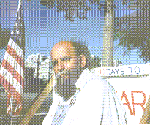 Charles L. Hyder
- 4/18/29 - 6/8/04
Charles L. Hyder
- 4/18/29 - 6/8/04
After completing his bachelor's and master's degrees here at
UNM, Charlie
earned
his Ph.D. in
Astrogeophysics
from the University of Colorado (1964).
He published more
than
twenty
solar and comet papers, and worked for NASA,
UCLA, UNM, and the
Southwest
Research & Information Center.
A native of Albuquerque,
he was an early
whistle-blower,
presenting
effective
criticism of plans for radwaste disposal in New Mexico
(particularly
at WIPP).
He and 19 other radwaste
experts were employed by the
government
of Lower
Saxony to critique the Gorleben Salt Dome project, which was
ultimately
rejected. Charles was dedicated to
environmental causes and the anti-nuclear movement. He staged an
anti-nuclear vigil at the White
House
beginning in April 1985, and in November 1985 he gave away his last
major possession...a car. His
protests and fasting gained worldwide attention, but probably caused
his poor health in later years.
Charles is survived by his brother Donald, and his sister Josala, as
well as four of his five children: Paul,
Roxanne, Querida, and Niels.
 Roger
A. Morris - d. 11/10/99
Roger
A. Morris - d. 11/10/99
Roger Morris, an original member of the STURP ("Shroud
of Turin Research Project") team that
examined
the Shroud of Turin
in 1978, died at his home in White Rock, New
Mexico,
after a short illness. He worked as a
physicist at Los Alamos National Laboratory from 1961
until his retirement in December
1997 (Nondestructive
Testing group). Roger is survived
by his wife Kay Morris, their five children, his
brother and his aunt.
He was remembered as an enthusiastic and dedicated
scientist
and as an effective team leader. Roger's
contribution to Shroud research was
significant:
in the early 1980s, he published reports on the direct
x-ray fluorescence and radiographic
measurements
that he, together with Ron London and
Bill Mottern,
conducted on the Shroud.
Donald S. Robb - 1929-1988
Munson M. Thorpe - 10/14/1928-2/22/1981
1970s [ back to top
]
Luella Mary W. Button - 1/17/1929-8/15/1999
She and her husband Donald lived in Abiquiu for 25
years
and,
at the time of her death (due to an automobile
accident),
she was retired from
Los Alamos National Lab. Luella was originally
from
North
Dakota.
Riki Darling - 6/23/1943-10/3/2001
Riki was one of the founding members of Utah's Wasatch Woolpack
Handspinners. She was an adventurous knitter, a
spinner
and weaver of Navajo-type rugs, and she taught
others
how to do
anything that she knew how to do.
William G. Larsen - 1953-1990
The William G. Larsen Memorial Student Award was
established
in 1990 by Mr. & Mrs. N.G. Larsen, in his memory,
and is presented to the
best Teaching Assistant during the UNM Physics
&
Astronomy
departmental graduation
ceremony each May.
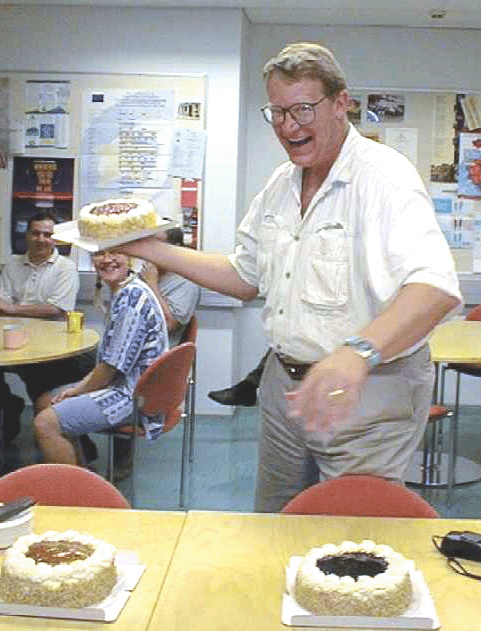 Harold G. Longbotham -
9/4/1946-9/5/1997
Harold G. Longbotham -
9/4/1946-9/5/1997
Dr. Longbotham earned degrees in Mathematics, Physics,
Statistics, and Electrical
Engineering. His bachelor degree was
in Physics and Mathematics from Stephen F. Austin,
where he also played football. He also had a masters degree in Physics from the University
of New Mexico,
in Statistics from the University of Texas at San Antonio, and a masters and
doctorate in Electrical
Engineering
from the University of Texas at Austin (Dec. 1988),
where
he studied image processing under Dr. A.C.
Bovik.
Dr. Longbotham held Assistant and Associate
Positions
at
the University of Texas at San
Antonio. In 1992, he participated in a start up
venture, CMI, which
specialized
in nonlinear
signal and image processing and modeling of
human system. This company grew to a total
of 22 scientist and engineers in 4 years without any
borrowing of capital. In January of 1996,
he sold
the majority of his stock in CMI and returned to full time work at UTSA, where he
became Chairman/Coordinator
of Electrical Engineering.
At UTSA Dr. Longbotham had sponsored research from
NIH,
DOD, AFOSR, DOE, and several private companies.
Most
of this research was in the areas of
signal and image processing, with his ultimate interest
turning to the application of
robust nonlinear
techniques in ANN's and Fuzzy Logic. He published approximately 50 papers in the area of signal and
image
processing, was an Associate Editor of IEEE Image Processing, was Co-Chair of the San Jose Conference on
Non-
linear Image Processing for 3 years, and was a
Visiting Scientist at Brooks AFB, Los Alamos National
Lab, and Tampere
University of Technology.
Dr. Jacqueline Longbotham Ackley and Mr. & Mrs.
Harold
H. Longbotham endowed The Dr. Harold G. Longbotham
Scholarship at UTSA, and The Conceptual
MindWorks,
Inc.-Dr. Harold G. Longbotham Scholarship was
established at
Alamo Community College.
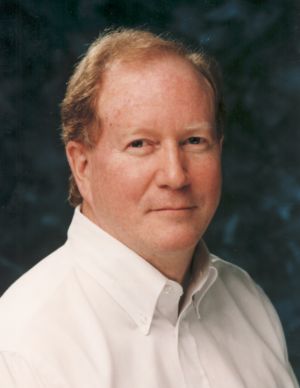 G. Christian Overton - 1948-2000
G. Christian Overton - 1948-2000
Dr. Overton was an associate professor in the
Department
of Genetics of the University of Pennsylvania
School of Medicine, and the founding director of the
Center for Bioinformatics at the University of
Pennsylvania School of Medicine. He received a B.S.
degree
in physics and mathematics from the
University of New Mexico, a Ph.D. degree in biophysics
from the Johns Hopkins University, and subsequently
an M.S.E. degree in computer science from the
University
of Pennsylvania. Prior to joining the University of
Pennsylvania faculty, he spent five years as part of
the artificial intelligence research group at the Unisys
Center for Advanced Information Technology. His
research
interests included the implementation of
databases for genome informatics and gene expression,
and the development of database technology for
the evolution, transformation, and integration of
databases.
He died unexpectedly on June 1, 2000, from
complications arising from cardiomyopathy. Dr. Overton
is survived by his wife, Carolyn; two sons, Aaron
and Graham, and two daughters, Johanna Hernandez and
Natalie Hernandez; his parents, William and Muriel
Overton, his brother John Overton and sister Ellen
Overton.
Dennis L. Roeder - 1945-1993
Ellery Storm - 3/10/1924-7/4/1989
Ellery and his wife Bernice worked at Los Alamos until
his death due to Parkinson's Disease; they had 17 great-grandchildren.
1980s [ back to top
]
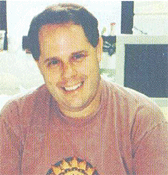 Richard
J. Elston
- 7/1/60-1/26/04
Richard
J. Elston
- 7/1/60-1/26/04
Richard earned his Ph.D. at the University of
Arizona in 1988, and joined the University of Florida in
Gaineseville as a professor
of Astronomy. He and
his wife,
Professor Elizabeth Lada, used infrared telescopes
to discover
circumstellar disks that were 10 to 100 times as large as the solar
system (spring 2003), making
AAS news and The New York Times
with their observations
of protoplanetary disks; Richard also received
the
2000 Presidential Science Award. Stanley F. Dermott,
Chair of the Astronomy
Department at the University
of Florida, wrote that, "Richard Elston passed away on
Monday, January 26 after a long and courageous battle
with cancer. Richard was one of the founders of the modern astronomical
research program at the University
of Florida, one of the leading astronomical instrumentalists of his
generation, and a good friend, colleague and
mentor. Our thoughts are now with his wife, Elizabeth, and their young
son, Joseph. He will be deeply missed."
Arthur R. Gribble - 10/9/58-April 1990
Robert T. Marchini - 4/4/43-1/21/83
"My oldest brother, Robert Thomas Marchini, was born
April
4, 1943, in Passaic General Hospital [NJ] to Robert
and Lydia Marchini.
He received his BS in biology from Fairleigh
Dickinson
University in Rutherford, NJ, and did
some additional study at
University
of Florida in marine biology
before transferring to UNM
where he received
his masters in physics while working towards the
doctorate.
He died January 21, 1983, near Los
Alamos. He was
survived by his parents (Lydia has since died - 1997) and brothers:
Fred of Ridgewood, NJ; Ken Italo of
Montclair,
NJ;
and Andrew of NYC." -Ken Italo
Marchini
<IKMarchini@aol.com>
11/21/02
1990s [ back to top
]
Denis
Khetselius - 11/17/63-2/7/05
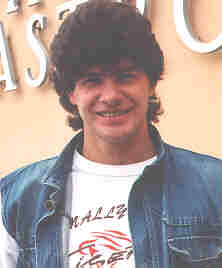 Denis
Khetselius, who earned his Ph.D. here in 1996 for his work on the
twisting type-
Denis
Khetselius, who earned his Ph.D. here in 1996 for his work on the
twisting type-
N prolongation problem ("Nonlocal Prolongations for the Twisting Type-N
Einstein
Vacuum Field Equations with One Killing Vector"), and who originally
discovered the
systen of vector-field-valued PDEs association with s/(2, C), passed
away on February
7th. Although he had a rough month - spending about 3 out of the
last 4 weeks in
Presbyterian Hospital - friends said that he sounded energetic and
upbeat the last
night...glad to
be home and not in a hospital bed. He spent most of the evening helping
a friend with some physics problems
Chuck Gasparovic, a colleague with the SoM, wrote:
"I think that all of us who had contact with Denis - whether when he
was
imposingly strapping and healthy
or after he was severely debilitated by
ameloidosis - realized almost immediately what a fine human being
he was
- so intelligent, yet always humble and always thinking of those around
him. He certainly suffered,
both physically and psychologically, in
these last few years of his disease. Yet he would always greet you
with
a smile, ask about your family, and want to talk about science,
politics, hockey, anything but feeling
sorry for himself. His strength
was incredible.
His mother, who lost her husband to the same disease, is,
of course,
grief stricken, but dealing with it."
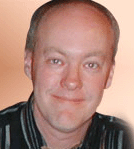 Michael
Ledlow - 10/1/64-6/6/04
Michael
Ledlow - 10/1/64-6/6/04
Michael Ledlow, staff astronomer at Gemini South, died suddenly
in Denver on Saturday June 5th,
2004.
Michael had just attended the Gemini Science 2004
Conference in Vancouver and was on vacation with his family
in
Colorado.
Michael was born in Bartlesville, Oklahoma on
October 1st,
1964. He obtained his Bachelor’s Degree in
astrophysics at the
University of Oklahoma in 1987, and attended UNM for his graduate
work. He obtained his
Ph.D under Steve Gregory and Frazer
Owen in 1994. Michael joined Gemini in June 2000 as a Gemini Science
Fellow
and was promoted to a tenure track astronomer in 2001.
Michael
led an active life as a Gemini astronomer supporting both the community
and his research career studying
distant galaxies and galaxy clusters. His infrared work at Gemini South
was instrumental in complementing
research by the team leader,
Dr. William Keel with the University of
Alabama, and Dr. Frazer Owen with the National Radio Astronomy
Observatory. Through a
combination of radio, optical and infrared
observations, they confirmed the existence of a giant, subatomic
particle jet streaming from a
spiral
galaxy similar to the Milky Way. The galaxy, known as 0313-192, first
came to the attention of Dr. Owen
more than 20 years ago
during a galaxy survey he conducted using the
Very Large Array (VLA).
Michael’s
untimely death is a tragic loss for his family, the Gemini Observatory
and the astronomical community. He was beloved by many
and will
be greatly missed. Michael
is survived by his wife Cheryl, two young daughters Alexandria and
Abigail, and three step-daughters
as well as numerous other family
members.
To the family and friends of Michael Ledlow:
What a shock to receive the announcement from the UNM PandA alumni exploder of
Michael's untimely death. Michael and I overlapped for a short time while I was
finishing my Ph.D. with Jack Burns at UNM. He had started out with Jack as
well, but I think it was when Jack left UNM for Las Cruces that Michael started
working more closely with Fraser Owen.
My overlap with Mike "Redrow" was long enough to have gained a wonderful rapport
with an incredibly gentle man. I shall always remember him for his easy smile,
his gentle demeanour, and his quiet brilliance. He shared an office with
myself, my wife to be (Jodi Asbell, who also sends her condolences), and with a
mutual friend, Jun-Hui Zhao, whose pronounciation of Michael's last name gave
Michael his office nickname.
My deepest condolences go out to his young family, his colleagues, his friends,
his parents, and of course his wife. It breaks my heart to think his children
have had their father ripped away from them at such a young age, and the only
compensation I can think of is that Michael was such a principled and
compassionate man, that he has likely imparted upon his children more of himself
in his short time with them than many parents are able to do in a full lifetime.
God speed, Michael.
David Clarke (UNM class of 1988)
Halifax
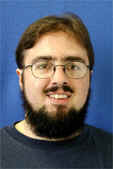 Christopher
K. Schultz -
3/27/70-June 2002
Christopher
K. Schultz -
3/27/70-June 2002
Chris Schultz earned a Bachelor of Science
Degree in Physics from the
University of New Mexico in May 2000, at which
time he earned the
Feynman Award for Best Student in Contemporary Physics. As a top
student, he was actively recruited by the
Optical Sciences Center at
the University of Arizona where he accepted a Graduate Research
Assistantship.
Shortly after Chris began his studies at the Optical Sciences
Center, he joined Bernard Kippelen’s research group.
Under Professor
Kippelen’s direction, Chris was actively involved in two projects: a
research program focusing on
the development of electro-active lenses
using liquid crystals and a second project investigating the
fabrication
and characterization of field-effect transistors based on
organic molecules.
An outstanding student, Chris was beginning to demonstrate
his
potential as a scientist through his discipline, initiative and
collaborative abilities. For this he was respected. Chris was also a
valued friend who was sensitive to others and generously shared
his
time, talents and resources -- and for this he was loved.
In Chris’s memory, a scholarship has been
established by his family, friends and colleagues at the Optical
Sciences Center. When the
scholarship is awarded, the recipient will be
a second-year Optical Sciences Center Ph.D. student with outstanding
scholastic ability
and research promise in applied optics.
Contributions in any amount are welcome and will be very greatly
appreciated.
To contribute, please make your check payable to
The University of Arizona, with a memo that it is for The Christopher
Karl Schultz
Memorial Scholarship. Mail it to Ms. Ruth Smith,
Accounting Manager, Optical Sciences Center, P.O. Box 210094, Tucson,
Arizona
85721--0094 USA. If you would like to contact Ms. Smith
directly, she can be reached by email at ruths@u.arizona.edu
or
by telephone
at 520-621-8155. With your
help, we hope the Christopher Karl Schultz Memorial Scholarship will
represent an appropriate and
lasting memorial to a gifted young man who
valued academic and research excellence.
2000s [ back to top
]
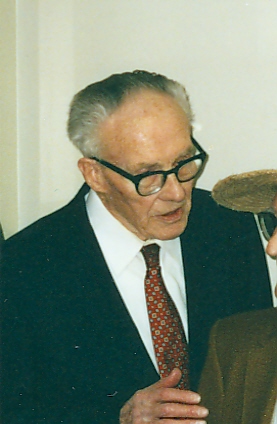
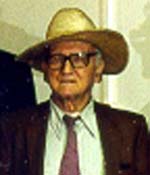
 Marx
Brook - 7/12/20-9/3/02
Marx
Brook - 7/12/20-9/3/02
 Gus
T. Zorn - 6/18/1924-1/30/2002
Gus
T. Zorn - 6/18/1924-1/30/2002
 Charles L. Hyder
- 4/18/29 - 6/8/04
Charles L. Hyder
- 4/18/29 - 6/8/04 Roger
A. Morris - d. 11/10/99
Roger
A. Morris - d. 11/10/99
 Harold G. Longbotham -
9/4/1946-9/5/1997
Harold G. Longbotham -
9/4/1946-9/5/1997
 G. Christian Overton - 1948-2000
G. Christian Overton - 1948-2000
 Richard
J. Elston
-
Richard
J. Elston
-  Michael
Ledlow
Michael
Ledlow Christopher
Christopher